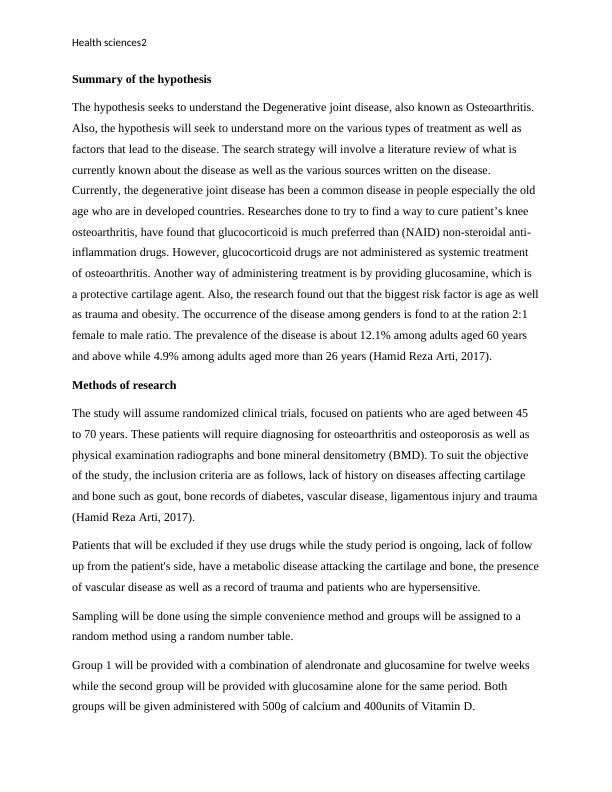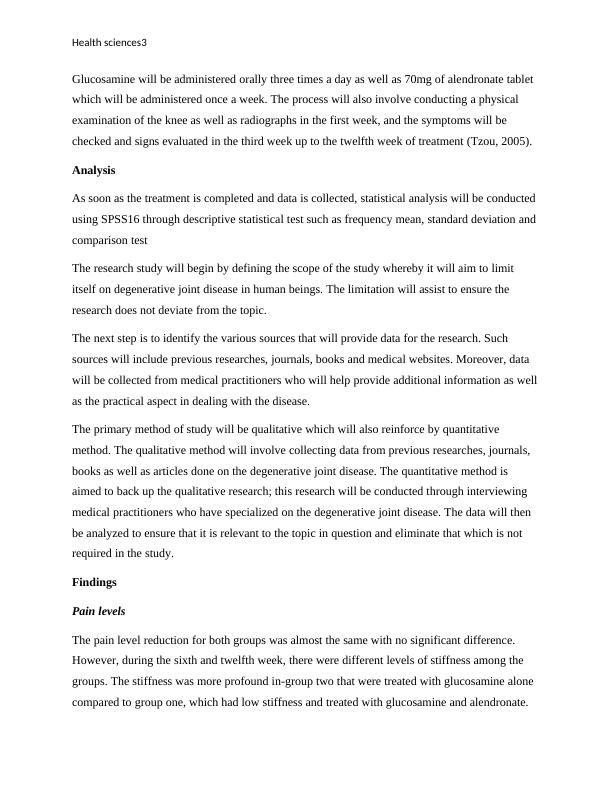Understand the Various Types of Treatment Factors that Lead to the Disease
6 Pages1591 Words106 Views
Added on 2020-02-18
Understand the Various Types of Treatment Factors that Lead to the Disease
Added on 2020-02-18
ShareRelated Documents
Running head: Health sciencesHealth sciences Name LecturerInstitution affiliationDate

Health sciences2Summary of the hypothesis The hypothesis seeks to understand the Degenerative joint disease, also known as Osteoarthritis. Also, the hypothesis will seek to understand more on the various types of treatment as well as factors that lead to the disease. The search strategy will involve a literature review of what is currently known about the disease as well as the various sources written on the disease. Currently, the degenerative joint disease has been a common disease in people especially the old age who are in developed countries. Researches done to try to find a way to cure patient’s knee osteoarthritis, have found that glucocorticoid is much preferred than (NAID) non-steroidal anti-inflammation drugs. However, glucocorticoid drugs are not administered as systemic treatment of osteoarthritis. Another way of administering treatment is by providing glucosamine, which is a protective cartilage agent. Also, the research found out that the biggest risk factor is age as wellas trauma and obesity. The occurrence of the disease among genders is fond to at the ration 2:1 female to male ratio. The prevalence of the disease is about 12.1% among adults aged 60 years and above while 4.9% among adults aged more than 26 years (Hamid Reza Arti, 2017).Methods of researchThe study will assume randomized clinical trials, focused on patients who are aged between 45 to 70 years. These patients will require diagnosing for osteoarthritis and osteoporosis as well as physical examination radiographs and bone mineral densitometry (BMD). To suit the objective of the study, the inclusion criteria are as follows, lack of history on diseases affecting cartilage and bone such as gout, bone records of diabetes, vascular disease, ligamentous injury and trauma(Hamid Reza Arti, 2017).Patients that will be excluded if they use drugs while the study period is ongoing, lack of follow up from the patient's side, have a metabolic disease attacking the cartilage and bone, the presenceof vascular disease as well as a record of trauma and patients who are hypersensitive.Sampling will be done using the simple convenience method and groups will be assigned to a random method using a random number table. Group 1 will be provided with a combination of alendronate and glucosamine for twelve weeks while the second group will be provided with glucosamine alone for the same period. Both groups will be given administered with 500g of calcium and 400units of Vitamin D.

Health sciences3Glucosamine will be administered orally three times a day as well as 70mg of alendronate tablet which will be administered once a week. The process will also involve conducting a physical examination of the knee as well as radiographs in the first week, and the symptoms will be checked and signs evaluated in the third week up to the twelfth week of treatment (Tzou, 2005).Analysis As soon as the treatment is completed and data is collected, statistical analysis will be conducted using SPSS16 through descriptive statistical test such as frequency mean, standard deviation and comparison testThe research study will begin by defining the scope of the study whereby it will aim to limit itself on degenerative joint disease in human beings. The limitation will assist to ensure the research does not deviate from the topic.The next step is to identify the various sources that will provide data for the research. Such sources will include previous researches, journals, books and medical websites. Moreover, data will be collected from medical practitioners who will help provide additional information as wellas the practical aspect in dealing with the disease.The primary method of study will be qualitative which will also reinforce by quantitative method. The qualitative method will involve collecting data from previous researches, journals, books as well as articles done on the degenerative joint disease. The quantitative method is aimed to back up the qualitative research; this research will be conducted through interviewing medical practitioners who have specialized on the degenerative joint disease. The data will then be analyzed to ensure that it is relevant to the topic in question and eliminate that which is not required in the study.Findings Pain levelsThe pain level reduction for both groups was almost the same with no significant difference. However, during the sixth and twelfth week, there were different levels of stiffness among the groups. The stiffness was more profound in-group two that were treated with glucosamine alone compared to group one, which had low stiffness and treated with glucosamine and alendronate.

End of preview
Want to access all the pages? Upload your documents or become a member.
Related Documents
HLT1RAE, The Most Common Cause of Chronic Disability Among Elderly Peoplelg...
|3
|590
|30
Statistical Analysis on Clinical Triallg...
|14
|2824
|304
Statistical Analysis on Clinical Trial Reportlg...
|15
|2864
|31
Statistical Analysis on Clinical Triallg...
|15
|2819
|40
